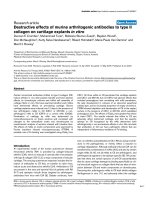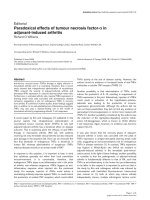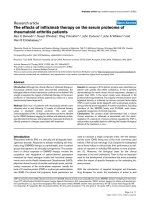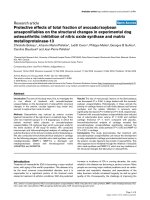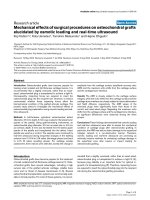Báo cáo y học: "Anti-inflammatory effects of Radix Gentianae Macrophyllae (Qinjiao), Rhizoma Coptidis (Huanglian) and Citri Unshiu Pericarpium (Wenzhou migan) in animal models" doc
Bạn đang xem bản rút gọn của tài liệu. Xem và tải ngay bản đầy đủ của tài liệu tại đây (323.39 KB, 7 trang )
BioMed Central
Page 1 of 7
(page number not for citation purposes)
Chinese Medicine
Open Access
Research
Anti-inflammatory effects of Radix Gentianae Macrophyllae
(Qinjiao), Rhizoma Coptidis (Huanglian) and Citri Unshiu Pericarpium
(Wenzhou migan) in animal models
Kyoung Soo Kim*
1
, Hae In Rhee
2
, Eun Kyung Park
1
, Kiwon Jung
2
,
Hyo Jin Jeon
2
, Ji-Hong Kim
2
, Hunseung Yoo
2
, Chang-Kyun Han
3
, Yong-
Baik Cho
4
, Chun Jeih Ryu
5
, HyungInYang
6
and Myung Chul Yoo*
7
Address:
1
East-West Bone and Joint Research Center, Kyung Hee University Neo Medical Hospital, 149 Sangil-dong, Gangdong-gu, Seoul 134-090,
South Korea,
2
Life Science Research Center, SK Chemicals, 600 Jungja-1-dong, Changan-Ku, Suwon-Si, Kyoungki-Do 440-745, South Korea,
3
Central R&D, Ahngook Pharm., Iui-Dong Yeongtong-gu, Suwon-Si, Kyoungki-Do, South Korea,
4
Central Research Institute, Whan In Pharm., Co.,
Ltd. Iui-Dong, Yeongtong-gu, Suwon-Si, Kyoungki-Do, South Korea,
5
Department of Bioscience and Biotechnology, Sejong University, Seoul 143-
747, South Korea,
6
Department of Internal Medicine, Kyung Hee University Neo Medical Hospital, 149 Sangil-dong, Gangdong-gu, Seoul 134-
090, South Korea and
7
Department of Orthopedic Surgery, Kyung Hee University Neo Medical Hospital, 149 Sangil-dong, Gangdong-gu, Seoul
134-090, South Korea
Email: Kyoung Soo Kim* - ; Hae In Rhee - ; Eun Kyung Park - ;
Kiwon Jung - ; Hyo Jin Jeon - ; Ji-Hong Kim - ;
Hunseung Yoo - ; Chang-Kyun Han - ; Yong-Baik Cho - ;
Chun Jeih Ryu - ; Hyung In Yang - ; Myung Chul Yoo* -
* Corresponding authors
Abstract
Background: KHU14, an ethanolic extract of Radix Gentianae Macrophyllae (Qinjiao), Rhizoma
Coptidis (Huanglian) and Citri Unshiu Pericarpium (Wenzhou migan) was tested for its anti-
inflammatory effects.
Methods: Three out of 20 herbs were found to have anti-inflammatory effects. The formulation
of these herbs, i.e. KHU14 was tested for croton oil-induced ear edema, carrageenan-induced paw
edema, acetic acid-induced capillary permeability, cotton pellet and delayed type hypersensitivity.
Results: KHU14 exhibited anti-inflammatory effects in animal models of acute and chronic
inflammation. The anti-inflammatory activity of KHU14 observed was comparable to that of
celecoxib. KHU14 inhibited the production of NO and PGE
2
in LPS/IFN-gamma-stimulated
peritoneal macrophages, and reduced edema and the amount of infiltrated cells in animal models.
Conclusion: KHU14 exhibited anti-inflammatory effects as demonstrated in typical immunological
tests for anti-inflammation in vitro and in vivo.
Background
Herbal extracts from traditional Chinese medicine can be
formulated to develop novel herbal medicines as potent
as synthetic medicines [1-3]. We investigated in vitro anti-
inflammatory properties of 20 medicinal herbs used in
Chinese medicine in order to develop a new herbal for-
Published: 2 September 2008
Chinese Medicine 2008, 3:10 doi:10.1186/1749-8546-3-10
Received: 14 June 2007
Accepted: 2 September 2008
This article is available from: />© 2008 Kim et al; licensee BioMed Central Ltd.
This is an Open Access article distributed under the terms of the Creative Commons Attribution License ( />),
which permits unrestricted use, distribution, and reproduction in any medium, provided the original work is properly cited.
Chinese Medicine 2008, 3:10 />Page 2 of 7
(page number not for citation purposes)
mulation to treat inflammation. Three herbs, namely
Radix Gentianae Macrophyllae (Qinjiao) [4,5], Rhizoma Cop-
tidis (Huanglian) [6] and Citri Unshiu Pericarpium (Wen-
zhou migan) [7,8], demonstrated anti-inflammatory
effects in various experimental models. The primary ingre-
dient in Radix Gentianae Macrophyllae is gentiopicroside
which was shown to have anti-inflammatory effects in a
murine model of hepatic injury [9]. Berberine, which has
strong anti-inflammatory effects [10-12], is a major active
constituent of Rhizoma Coptidis. Hesperidin [13] and
nobiletin [14], both of which exhibit anti-inflammatory
effects, are the active ingredients in Citri Unshiu Pericar-
pium [15,16]. Our in vitro screening and other available
information suggests that these three herbs have potential
anti-inflammatory effects. Therefore, these three herbs
were selected for a formulation, i.e. KHU14. The present
study tests the anti-inflammatory actions of KHU14 in
several animal models of inflammation.
Methods
Materials
Carboxymethyl cellulose (CMC), dexamethasone, olive
oil, 4-ethoxymethylene-2-phenyloxazolone, acetone, car-
rageenan, croton oil, Evans blue, and Griess regent (1%
sulfanilamide and 0.1% N- [napthyl] ethylenediamine
dihydrochloride in 2.5% H
3
PO
4
) were purchased from
Sigma (USA). Celecoxib (capsules) was purchased from
Pfizer Pharmaceuticals (Korea). ELISA kits for interleukin-
2 and interferon-γ and the immunoassay kit for PGE
2
were
purchased from R&D Systems (USA). RPMI 1640 (Gibco,
UK) and DMEM (Invitrogen, UK), antibiotic-antimycotic
solution (Gibco, UK) and fetal bovine serum (FBS, CAM-
BREX, USA) were used as media for cell culture. The 20
herbs used in the present study were purchased from
Kyung Hee Oriental Medical Hospital.
Animals
Female BALB/c mice (5–6 weeks old, 16–18 g) and male
ICR mice (5–6 weeks old, 16–18 g) were obtained from
Orient Co Ltd (Korea). Male Wistar rats (5–6 weeks old,
200–300 g) were obtained from SLC Co Ltd (Japan). All
animals were kept in plastic cages at 21–24°C under a 12
hour light/dark cycle and were given free access to pellet
food and water. The mice were fed with 200 μl of the
extract solution and the rats were fed with 2 ml of the
same. This study complied with the internationally
accredited guidelines and ethical regulations on animal
research.
Preparation of plant extracts
Powdered Radix Gentianae Macrophyllae, Rhizoma Coptidis
and Citri Unshiu Pericarpium were obtained from Kyung
Hee Oriental Medical Hospital (South Korea). The pow-
ders of these herbs (200 g each) were mixed by blending
and then extracted twice with 50% ethanol (1800 ml) at
80°C for 4 hours. The combined ethanolic extracts were
filtered and concentrated in a rotary evaporator at 40°C.
The yield (59.5 g), code named KHU14 (KHU referring to
Kyung Hee University), was then dissolved in 0.5% car-
boxylmethyl cellulose (CMC) solution (0.5 g CMC in 100
ml of distilled water) for the subsequent in vivo experi-
ments. The voucher specimens of the plants used in this
study were stored in the department herbarium for future
reference.
Measurement of cell viability
Cell viability was assessed by the 3'-(4,5-dimethylthia-
zole-2yl)-2,5-diphenyltetrazolium bromide (MTT) assay.
RAW264.7 cells (1 × 10
4
cells/well) were seeded in tripli-
cates of 24-well plates and cultured in 1 ml of Dulbecco's
Modified Essential Medium (DMEM) containing 10%
fetal bovine serum (FBS) overnight. After treated with
KHU14 for one hour, cells were stimulated with 1 μg/ml
of LPS for 72 hours and MTT (0.5 mg/ml) was added in
the third hour. After the removal of the medium and the
addition of 500 μl of DMSO to the well, the optical den-
sity (OD) absorbance was measured at 570 nm.
Western blot anlysis
RAW264.7 cells cultured (1 × 10
6
cells) in 60 mm dishes
were serum-starved overnight. After the cells were treated
with KHU14 for 1 hour, the cells were stimulated by LPS
(1 μg/ml) for 24 hours. The cells were subsequently
washed twice in PBS and treated with 50 μl of lysis buffer
(20 mM Tris-Cl [pH 8.0], 150 mM NaCl, 1 mM EDTA, 1%
Triton X-100, 20 μg/ml chymostatin, 2 mM PMSF, 10 μM
leupeptin, and 1 mM 4-(2-aminoethyl) benzenesulfonyl
fluoride [AEBSF]). The samples were separated with 12%
SDS-PAGE and were then transferred to Hybond-ECL
membranes (Amersham, USA). The membranes were first
blocked with 6% nonfat milk dissolved in TBST buffer (10
mM Tris-Cl [pH 8.0], 150 mM NaCl, 0.05% Tween 20).
The blots were then probed with various rabbit polyclonal
antibodies for iNOS, COX-2 and β-actin (Cell Signaling
Technology, USA) diluted 1:1000 in TBS for 2 hours and
incubated with 1:1000 dilutions of goat anti-rabbit IgG
secondary antibody coupled with peroxidase. The blots
were developed with the ECL method (Amersham, USA).
For re-probing, the blots were incubated in the stripping
buffer (100 mM 2-mercaptoethanol, 2% SDS, 62.5 mM
Tris-HCl [pH 6.7]) at 50°C for 30 minutes with occa-
sional agitation.
Preparation of activated peritoneal macrophages from
mice
Resident macrophages were obtained by peritoneal lavage
according to a previously published method [17]. Briefly,
the mice were injected intraperitoneally with 1 ml of
Brewer thioglycollate medium (3%); and peritoneal fluids
were harvested after three days. The peritoneal exudates
Chinese Medicine 2008, 3:10 />Page 3 of 7
(page number not for citation purposes)
were centrifuged at 2000 rpm (931 × g, Allegra™ X-12R
Centrifuge, Beckman Coulter, USA) for 5 minutes at 4°C.
The cell pellets were washed twice with DMEM containing
10% FBS, 100 U/ml penicillin, 100 mg/ml streptomycin.
The washed cells were stimulated with lipopolysaccharide
(LPS, 1 μg/ml) and IFN-γ (1 ng/ml) for 96 hours on 96-
well plates (2 × 10
5
cells in 200 μl of medium per well) for
the nitric oxide (NO) assay, and 24 hours on 24-well
plates (each well contains 1 × 10
6
cells in 1 ml of medium)
for the prostaglandine E
2
(PGE
2
) assay.
NO and PGE
2
assays
Total NO production may be measured by nitrite assay as
NO is rapidly converted to nitrite and nitrate water.
Briefly, 100 μl of the culture supernatant was incubated at
room temperature for 10 minutes with 100 μl of Griess
reagent (1% sulfanilamide, 0.2% N-(1-naphthyl) ethylen-
ediamine dihydrochloride in 2.5% H
3
PO
4
). The OD was
measured at 570 nm and nitrite concentration was deter-
mined with a standard curve. We used an enzyme immu-
noassay kit to measure the PGE
2
production in the culture
supernatant following the manufacturer's instructions
(R&D Systems, USA).
Ear edema induced by croton oil
The inner surface of the right ear of the male ICR mice was
treated with 20 μl of freshly prepared croton oil (2.5% in
acetone). The left ear was treated with 20 μl of acetone as
control [18]. The thickness of the ear edema was meas-
ured with an engineering gauge (Model H, Peacock,
Japan) 4 hours after the application of the irritant. Sixty
minutes prior to the induction of edema, KHU14 (400
mg/kg of body weight), celecoxib (100 mg/kg of body
weight) and vehicle (0.5% CMC) were orally adminis-
tered to three groups of animals which had fasted for four
hours. Edema was measured as the difference between the
thickness of the control ear and that of the ear treated with
croton oil.
Paw edema induced by carrageenan
Each of the male Wistar rats was injected with 0.1 ml of a
freshly prepared suspension of carrageenan in saline (2.0
mg/ml) in the subplanta tissue of the right hind paw. An
equal volume of saline was injected into the left hind paw
as control. We made some modifications to the previously
described murine paw edema model [19]. The volume of
the paw up to the tibiotarsal joint was measured with a
plethysmometer (Model 7140, Ugo Basile, Italy) one, two
and four hour(s) respectively after the induction of
inflammation. Edema was measured as the difference
between the volume of the paw of the control and that of
the paw injected with carrageenan. Sixty minutes prior to
the induction of edema, KHU14 (400 mg/kg of body
weight), celecoxib (100 mg/kg of body weight) and vehi-
cle (0.5% CMC) were orally administered to three groups
of animals which had fasted for 15 hours.
Capillary permeability increase induced by acetic acid
Vascular permeability increase induced by acetic acid in
the male ICR mice was determined following a modified
Whittle method [20]. KHU14 (400 mg/kg of body
weight), celecoxib (100 mg/kg of body weight) and vehi-
cle (0.5% CMC) were orally administered to three groups
of mice respectively. Thirty minutes after the administra-
tion, each mouse was intravenously injected (at the tail)
with 0.1 ml of 4% Evans blue (10 μl/g of body weight,
Sigma, USA) in saline. Fifteen minutes after the intrave-
nous injection, each mouse was intraperitoneally injected
with 0.1 M acetic acid (10 μl/g body weight). The mice
were sacrificed by ether 20 minutes after the acetic acid
injection. The viscera were exposed for one minute to
drain the blood and were washed with saline over a Petri
dish. The wash was poured into 10 ml volumetric flasks
through glass wool. Each flask contained 10 ml of dis-
tilled water and 0.1 ml of a sodium hydroxide solution
(0.1 M) was added to the flask to clear any turbidity
caused by proteins. The OD was measured at 590 nm.
Cotton pellet test
Two sterile cotton pellets (10 mg) were subcutaneously
delivered into the dorsum of the male ICR mice anesthe-
tized with ether. KHU14 (400 mg/kg of body weight),
celecoxib (100 mg/kg of body weight) and vehicle (0.5%
CMC) were orally administered to three groups of mice
respectively once daily for seven days. The mice were sac-
rificed on the 7
th
day by ether. The cotton pellets were
removed, dried at 37°C for 24 hours and weighed. The
results were expressed as the difference between the initial
weight (10 mg) and the final dry weight of the cotton pel-
lets.
Delayed type hypersensitivity
Female BALB/c mice were sensitized by epicutaneously
applying 25 μl of a mixture of acetone and olive oil (4:1)
containing 2% 4-ethoxymethylene-2-phenyloxazolone
on the shaved abdomen and thorax skin as described by
Blaylock et al. [21]. KHU14 (400 mg/kg of body weight),
dexamethasone (1 mg/kg of body weight) and vehicle
(0.5% CMC) were orally administered to three groups of
mice at one, three, and five days respectively after sensiti-
zation. One day after the last feed of test sample, all mice
were challenged by applying 10 μl of 0.5% oxazolone in a
mixture of acetone and olive oil (4:1) to the inner and
outer surfaces of the right ear. The inhibitory effect of the
test sample on the delayed type hypersensitivity (DTH)
reaction was determined in comparison to the DTH reac-
tion in 0.5% CMC-fed mice. The intensities of the DTH
reaction were measured as the difference between the
Chinese Medicine 2008, 3:10 />Page 4 of 7
(page number not for citation purposes)
right ear thickness and the left ear thickness 24 hours after
the 0.5% oxazolone challenge.
Statistical analysis
The results are expressed as mean and standard deviation
(SD). The statistical significance between groups was
determined by ANOVA and by non-parametric Kruskal-
Wallis test with the GraphPad Prism 4 software (Graph-
Pad, USA). P values less than 0.05 were considered to be
statistically significant.
Results and discussion
Selection of three herbal extracts from 20 herbs
To develop potent multiple herbal extracts with anti-
inflammatory effects, we evaluated the in vitro anti-
inflammatory effects of each herbal extract in terms of the
production of NO in LPS and IFN-γ-stimulated peritoneal
macrophages (Table 1). Out of the 20 herbs, three were
selected and combined to form KHU14 according to their
anti-inflammatory effects and traditional usage in Chi-
nese medicine and their major active ingredients. KHU14
was evaluated for its anti-inflammatory effects against
those of a single herb (Table 2).
Effects of KHU14 on cell viability and iNOS and COX-2
expression in RAW264.7 cells
To identify the toxic effect of KHU14, we tested its effects
on the viability of a murine macrophage cell line
(RAW264.7) with 0.025% trypan blue dye exclusion
method. The exposure of the cells to KHU14 (1–100 μg/
ml) for 72 hours showed no significant adverse effect on
the cell viability, while after exposure to KHU14 (200 μg/
ml) for 72 hours, the cell viability was reduced to 80% of
that of the control (Figure 1A). In addition, KHU14 (100
μg/ml) inhibited the expression of iNOS and COX-2 in an
LPS-activated RAW264.7 cell line without causing cyto-
toxicity (Figure 1B).
In vitro effects of KHU14 on NO and PGE
2
in peritoneal
macrophages
Macrophages play a central role in the overproduction of
pro-inflammatory cytokines and inflammatory mediators
such as NO (Figure 2A) and PGE
2
(Figure 2B). KHU14
(1–100 μg/ml) significantly inhibited LPS/IFN-γ-induced
NO and PGE
2
production in peritoneal macrophages in a
dose-dependent manner. KHU14 (100 μg/ml) inhibited
NO and PGE
2
production by 27% and 49% respectively.
In vivo effects of KHU14 on acute inflammation
We employed three animal models of acute inflammation
to evaluate the anti-inflammatory effects of KHU14: (1)
inhibition of croton oil-induced ear edema in mice; (2)
carrageenan-induced paw edema in rats; and (3) acetic
acid-induced permeability test in mice.
In the croton oil-induced ear edema model for testing the
topical anti-inflammatory effects of KHU14, the control
Effects of KHU14 on cell viability and iNOS and COX-2 expression in RAW264.7 cellsFigure 1
Effects of KHU14 on cell viability and iNOS and
COX-2 expression in RAW264.7 cells. (A) Cell viability.
(B) Western blot. RAW264.7 cells were treated with 0, 1,
10, 100, 200 μg/ml of KHU14 dissolved in DMSO one hour
before stimulated with LPS (1 μg/ml) for 72 hours for meas-
urement of cell viability. For western blot analysis, cells were
stimulated with LPS for 24 hours in the presence of KHU14.
The results are expressed as mean and SD.
0 1 10 100 200
0
50
100
Relative cell viability (%)
KHU14 (μ
μμ
μg/ml)
$
iNOS
COX-2
β
ββ
β-actin
0 1 10 100
KHU14 (μ
μμ
μg/ml)
%
P<0.05
Table 1: Effects of 20 single herbal extracts (100 μg/ml) on nitrite in mouse peritoneal macrophages stimulated by LPS and IFN-γ
123456*78*9101112131415*1617181920
mean (μM)61.355.452.248.850.245.341.847.950 44.950.165.840.639.138.253.145.339.138.440.1
SD 1.7 2.7 1.5 2.2 2.9 2.8 3.5 2.1 3.6 2.8 2.1 4.3 2.7 3.5 2.3 1.8 2.1 3.6 2.7 3.8
1 Sophora subprostrata; 2 Siegesbeckia pubescens; 3 Angelica acutiloba; 4 Vitex rotundifolia; 5 Anemarrhena asphodelodies; *6 Gentiana macrophylla; 7
Poria cocos; *8 Citrus unshiu; 9 Eucommia ulmodies; 10 Polygonatum sibiricum; 11 Cinnamomum cassia; 12 Chaenomels sinensis; 13 Atractylodes lancea; 14
Aralia cordata; *15 Coptis chinensis; 16 Clematis mandshurica; 17 Phellodendron amurensis; 18 Scutellaria baicalensis; 19 Cimicifuga heracalensis; 20 Pueraria
thunbergiana
*: Selected herbs for the KUH14 formulation
Table 2: Effects of KHU14 and its herbal components (100 g/ml)
on nitrite in mouse peritoneal macrophages stimulated by LPS
and IFN-γ
KHU14 Radix Gentianae
Macrophyllae
Rhizoma
Coptidis
Citri Unshiu
Pericarpium
Mean (μM) 40.2 49.2 41.9 50.7
SD 2.1 3.8 3.1 3.5
Chinese Medicine 2008, 3:10 />Page 5 of 7
(page number not for citation purposes)
group which received 0.5% CMC increased 81.8% in ear
thickness. The KHU14 and celecoxib groups increased
64.8% and 64.1% in ear thickness respectively. The results
indicate that KHU14 and celecoxib reduced ear thickness
by 20% (Figure 3A). In the carrageenan induced paw
edema test, the paw volume increased 51.8% in the con-
trol group which received CMC, while it increased 31.4%
and 32.3% in the celecoxib and KHU14 groups respec-
tively. The results indicate that celecoxib and KHU14
reduced paw edema by 40% and 38% respectively (Figure
3B). In the acetic acid-induced permeability test, celecoxib
group reduced permeability by 35%; KHU14, however,
did not significantly reduce the permeability of Evan blue
(Figure 3C).
In vivo effects of KHU14 on chronic inflammation
In the cotton pellet test, the dry cotton in CMC, celecoxib,
and KHU14 groups weighted 74.7 mg, 63.3 mg, and 55.3
mg respectively (Figure 4A). KHU14 inhibited the infiltra-
tion of immune cells by 26% with statistical significance.
In the oxazolone-induced DTH model, the right ear thick-
ness of the control group increased 72.1%, while it
increased 59.0% and 58.6% in the dexamethasone group
and KHU14 group respectively. The results indicate that
dexamethsone and KHU14 reduced ear swelling by 18%
and 19% respectively (Figure 4B).
The results of the present study suggest that KHU14 has
considerable potency in anti-inflammatory action and
that it can be used as an anti-inflammatory agent to treat
certain inflammatory diseases. To further determine its
therapeutic effects, we will evaluate the toxicity of KHU14
in vivo and in animal models of diseases such as collagen-
induced arthritis [22] and psoriasis-like skin diseases [23].
Future studies are warranted to determine the optimal
combination ratio for this formulation. Furthermore, the
action mechanisms by which KHU14 exerts its anti-
inflammatory effects remain to be elucidated.
Conclusion
The present study suggests that KHU14 exerts anti-inflam-
matory effects as it inhibits the production of NO and
PGE
2
in LPS/IFN-γ-stimulated peritoneal macrophages
and reduces edema and the amount of infiltrated cells in
animal models.
Abbreviations
CMC: carboxymethyl cellulose; DMEM: Dulbecco's Mod-
ified Essential Medium; DMSO: dimethyl sulfoxide; DTH:
delayed type hypersensitivity; IFN-γ: interferon-gamma;
iNOS: inducible nitric oxide synthase; LPS: lipopolysac-
charide; NO: nitric oxide; OD: optical density; PGE
2
: pros-
taglandine E
2
; SD: standard deviation.
Competing interests
The authors declare that they have no competing interests.
Authors' contributions
KSK and HIR conducted the experiments and data analy-
sis. EKP conducted the in vitro experiments. KJ and HJJ
prepared herbal extracts. JHK and HY assisted the in vivo
experiments. CKH, YBC and CJR were responsible for the
data analysis. HIY helped draft the manuscript. KSK and
MCY prepared the manuscript. All authors read and
approved the final manuscript.
Effects of KHU14 on the NO and PGE
2
production in mouse peritoneal macrophagesFigure 2
Effects of KHU14 on the NO and PGE
2
production in
mouse peritoneal macrophages. The cells were treated
with 0, 1, 10, 50 and 100 μg/ml of KHU14 dissolved in
DMSO respectively 30 minutes before stimulated with LPS (1
μg/ml) + IFN-γ (1 ng/ml) for 24 hours. The supernatants
were collected and used for the measurement of the amount
of (A) NO and (B) PGE
2
. The results are expressed as mean
and SD.
0 1 10 50 100
0
10
20
30
40
50
60
NO (PM)
0 1 10 50 100
0
10
20
30
40
50
KHU14 (Pg/ml)
PGE
2
(ng/ml)
$
%
P<0.05
P<0.05
Chinese Medicine 2008, 3:10 />Page 6 of 7
(page number not for citation purposes)
Anti-inflammatory effects of KHU14 on animal models of acute inflammationFigure 3
Anti-inflammatory effects of KHU14 on animal models of acute inflammation. (A) Ear edema in mice (n = 10). (B)
Paw edema in rats (n = 8). (C) Capillary permeability test (n = 15). The mice and rats were orally fed with KHU14 (400 mg/kg
of body weight) and celecoxib (100 mg/kg of body weight). The control group received 0.5% CMC orally. NS: not significant.
Ear edema
CMC
0.5%
Celecoxib
100mg/kg
KHU14
400mg/kg
50
60
70
80
90
Increase in ear thickness (%)
$
P<0.05
Permeability
0.0
0.5
1.0
1.5
2.0
2.5
O.D
&
P<0.05
NS
CMC
0.5%
Celecoxib
100mg/kg
KHU14
400mg/kg
P<0.05
Paw edema
0
10
20
30
40
50
60
70
Increase of paw volume (%)
%
CMC
0.5%
Celecoxib
100mg/kg
KHU14
400mg/kg
P<0.05
P<0.05
Anti-inflammatory effects of KHU14 on a mouse model of chronic inflammationFigure 4
Anti-inflammatory effects of KHU14 on a mouse model of chronic inflammation. (A) Cotton pellet test (n = 6). (B)
DTH (n = 12). The mice were orally fed with KHU14 (400 mg/kg of body weight) and celecoxib (100 mg/kg of body weight) for
cotton pellet test and dexamethasone (1 mg/kg of body weight) for DTH. The control group received 0.5% CMC orally. NS:
not significant.
Cotton pellet
40
50
60
70
80
90
100
110
Dry granuloma weight (mg)
NS
P<0.05
$
CMC
0.5%
Celecoxib
100mg/kg
KHU14
400mg/kg
DTH
20
40
60
80
100
Increase in ear thickness (%)
P<0.05
%
CMC
0.5%
Dexa
1μ
μμ
μg/kg
KHU14
400mg/kg
P<0.05
Publish with BioMed Central and every
scientist can read your work free of charge
"BioMed Central will be the most significant development for
disseminating the results of biomedical research in our lifetime."
Sir Paul Nurse, Cancer Research UK
Your research papers will be:
available free of charge to the entire biomedical community
peer reviewed and published immediately upon acceptance
cited in PubMed and archived on PubMed Central
yours — you keep the copyright
Submit your manuscript here:
/>BioMedcentral
Chinese Medicine 2008, 3:10 />Page 7 of 7
(page number not for citation purposes)
Acknowledgements
This work was supported by a research grant (03-PJ9-PG6-SO01-002) from
the Korean Ministry of Health and Welfare.
References
1. Chang SH, Sung HC, Choi Y, Ko SY, Lee BE, Baek DH, Kim SW, Kim
JK: Suppressive effect of AIF, a water extract from three
herbs, on collagen-induced arthritis in mice. Int Immunophar-
macol 2005, 5(9):1365-1372.
2. Lung YB, Seong SC, Lee MC, Shin YU, Kim DH, Kim JM, Ahn JH, Seo
JG, Park YS, Lee CS, Roh KJ, Han CK, Cho YB, Chan DY, Kwak WJ,
Jung KO, Park BJ: A four-week, randomized, double-blind trial
of the efficacy and safety of SKI306X: a herbal anti-arthritic
agent versus diclofenac in osteoarthritis of the knee. Am J
Chin Med 2004, 32(2):291-301.
3. Shin SS, Jin M, Jung HJ, Kim H, Jeong H, Choi JJ, Kim JM, Cho BW,
Chung SH, Lee YW, Song YW, Kim S: Suppressive effects of
PG201, an ethanol extract from herbs, on collagen-induced
arthritis in mice. Rheumatology 2003, 42(5):665-672.
4. Kwak WJ, Kim JH, Ryu KH, Cho YB, Jeon SD, Moon CK: Effects of
gentianine on the production of pro-inflammatory cytokines
in male Sprague-Dawley rats treated with lipopolysaccaride
(LPS). Biol Pharm Bull 2005, 28(4):750-753.
5. Yu F, Yu F, Li R, Wang R: Inhibitory effects of the Gentiana mac-
rophylla (Gentianaceae) extract on rheumatoid arthritis of
rats. J Ethnopharmacol 2004, 95(1):77-81.
6. Tse WP, Che CT, Liu K, Lin ZK: Evaluation of the anti-prolifera-
tive properties of selected psoriasis-treating Chinese medi-
cines on cultured HaCa T cells. J Ethnopharmacol 2006,
108(1):133-141.
7. Higashi-Okai K, Kamimoto K, Yoshioka A, Okai Y: Potent suppres-
sive activity of fresh and dried peels from Stsuma mandarin
Citrus unshiu (Marcov.) on hydroperoxide generation from
oxidized linoleic acid. Phytother Res 2002, 16(8):781-784.
8. Kim DK, Lee KT, Eun JS, Zee OP, Lim JP, Eum SS, Kim SH, Shin TY:
Anti-allergic components from the peels of Citrus unshiu.
Arch Pharm Res 1999, 22(6):642-645.
9. Kondo Y, Takano F, Hojo H: Suppression of chemically and
immunologically induced hepatic injuries by gentiopicroside
in mice. Planta Med 1994, 60(5):414-416.
10. Liu B, Li W, Chang Y, Dong Y, Ni L: Extraction of berberine from
rhizome of Coptis chinensis Franch using supercritical fluid
extraction.
J Pharm Biomed Anal 2006, 41(3):1056-1060.
11. Kuo CL, Chi CW, Liu TY: The anti-inflammatory potential of
berberine in vitro and in vivo. Cancer Lett 2004,
203(20):127-137.
12. Lee DU, Kang YJ, Park MK, Lee YS, Seo HG, Kim TS, Kim CH, Chang
KC: Effect of 13-alkyl-substituted berberine alkaloids on the
expression of COX-II, TNF-alpha, iNOS, and IL-12 produc-
tion in LPS-stimulated macrophages. Life Sci 2003,
73(11):1401-1412.
13. Kawaguchi K, Maruyama H, Kometani T, Kumazawa Y: Suppression
of collagen-induced arthtitis by oral administration of the
citrus flavonoid hesperidin. Planta Med 2006, 72(5):477-479.
14. Murakami A, Nakamura Y, Torikai K, Tanaka T, Koshiba T, Koshimizu
K, Kuwahara S, Takahashi Y, Ogawa K, Yano M, Tokuda H, Nishino
H, Mimaki Y, Sashida Y, Kitanaka S, Ohigashi H: Inhibitory effect of
citrus nobiletin on phorbolester-induced skin inflammation,
oxidative stress, and tumor promotion in mice. Cancer Res
2000, 60(18):5059-5066.
15. Lee NK, Choi SH, Park SH, Park EK, Kim DH: Antiallergic activity
of hesperdine is activated by intestinal microflora. Pharmacol-
ogy 2004, 71(4):174-180.
16. Sasaki K, Yoshizaki F: Nobiletin as a tyrosinase inhibitor from
the peel of Citrus fruit. Biol Pharm Bull 2002, 25(6):806-808.
17. Schiavoni G, Mauri C, Carlei D, Belardelli F, Pastoris MC, Proietti E:
Type I IFN protects permissive macrophages from
Legionella pneumophila infection through an IFN-gamma-
independent pathway. J Immunol 2004, 173(2):1266-1275.
18. Tubaro A, Dri P, Delbello G, Zilli C, Logia RD: The croton oil ear
test revisited. Agents Actions 1985, 17(3–4):47-49.
19. Kasahara Y, Hikino H, Tsurufiji S, Watanabe M, Ohuchi K: Anti-
inflammatory actions of ephedrines in acute inflammation.
Planta Med 1985, 51(4):325-331.
20. Yesilada E, Tanaka S, Sezik E, Tanbata M: Isolation of an anti-
inflammatory principle from the fruit juice of Ecballium ela-
terium. J Nat Prod 1988, 51(3):504-508.
21. Blaylock BL, Newsom KK, Holladay SD, Shipp BK, Bartow TA,
Mehendale HM: Topical exposure to chlordane reduces the
contact hypersensitivity response to oxazolone in BALB/c
mice. Toxicol Lett 1995, 81(2–3):205-211.
22. Schiavoni G, Mauri C, Carlei D, Belardelli F, Pastoris MC, Proietti E:
Type I IFN protects permissive macrophages from
Legionella pneumophila infection through an IFN-gamma-
independent pathway. J Immunol 2004, 173(2):1266-1275.
23. Tubaro A, Dri P, Delbello G, Zilli C, Logia RD: The croton oil ear
test revisited. Agents Actions 1985, 17(3–4):47-49.




